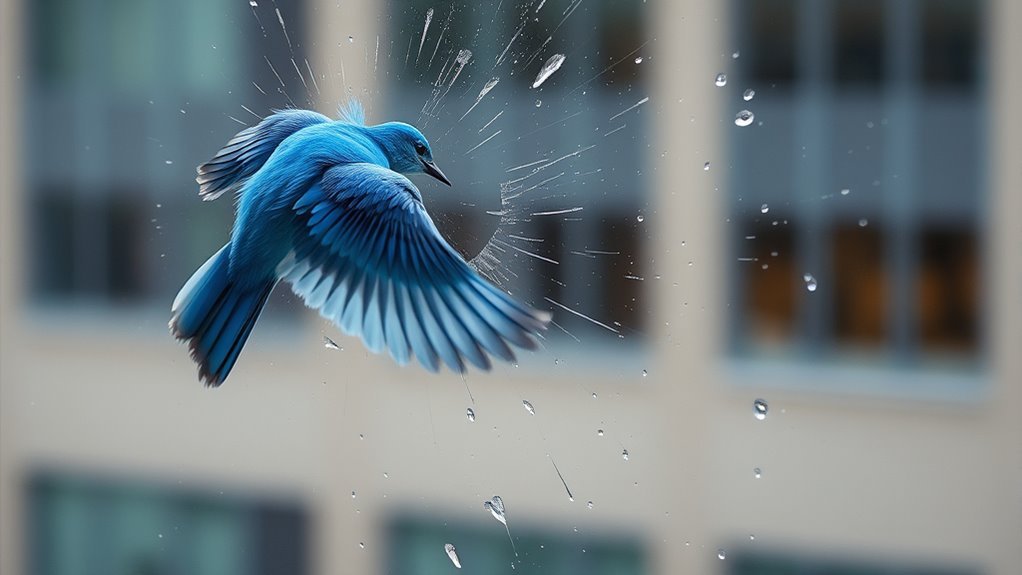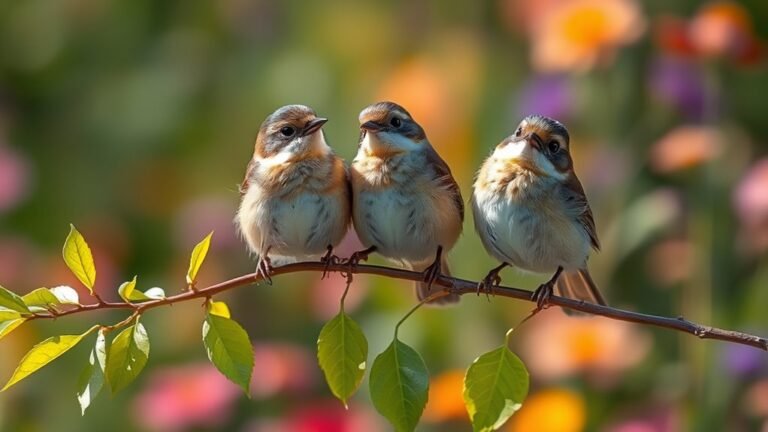Understanding the Significance of a Bird Crashing Into a Window
When a bird crashes into a window, it highlights how wildlife interacts with urban areas. These collisions occur for several reasons, revealing problems caused by human buildings. Each incident signals how our architecture affects bird behavior. By understanding these events, we can work towards better coexistence with wildlife. How can we solve these issues effectively?
Key Takeaways
- A bird crashing into a window reflects the impact of urban environments on wildlife, highlighting habitat loss and altered behaviors necessary for survival.
- The instinctual nature of birds leads to confusion with reflective surfaces, emphasizing the importance of designing bird-friendly buildings.
- Cultural symbolism associated with birds reinforces the spiritual and emotional connections humans share with wildlife, prompting reflection on our coexistence.
- Window strikes serve as a reminder of the need for preventative measures to enhance bird safety in cities, promoting environmental responsibility.
- Observing bird collisions raises awareness about the consequences of urbanization on natural species and encourages efforts for conservation and habitat protection.
The Biological Perspective: Why Birds Fly Into Windows

Birds often fly into windows due to their instincts and environmental cues. Their eyes are designed to see a wide range of colors, which can mislead them about glass surfaces.
They may see reflections of trees and the sky, thinking these are open spaces. Additionally, their natural urge to keep flying, combined with their quick movements, can lead to mistakes.
Understanding these biological reasons helps us see the need for bird-friendly spaces. We can reduce these incidents and create a better connection between humans and wildlife.
Environmental Factors Contributing to Window Strikes
Urban areas provide homes for many bird species, but they also create dangers. Building designs and landscaping choices can lead to window strikes. The loss of natural habitats forces birds to depend more on cities for shelter and food.
Developers often use reflective glass and large windows, which confuse birds and cause them to collide with buildings. Additionally, bright lights from cities attract birds away from safe paths, increasing the risk of dangerous encounters.
Cultural Interpretations and Symbolism of Birds

Birds hold meaning in many cultures. They symbolize freedom and spirituality. Their ability to fly represents liberation. In various mythologies, this flight makes them strong symbols. For instance, many Native American cultures see birds as messengers. They connect humans to the spirit world.
In ancient Egypt, people honored birds like the falcon, associating them with the divine. This cultural meaning helps us understand birds as more than just animals. They also reflect our hopes, dreams, and aspirations.
When we see a bird unexpectedly hit a window, it can spark thoughts about these meanings. This moment may invite us to reflect on our connection to life and culture.
The Role of the Urban Environment in Bird Behavior
Urban environments change how birds behave. As cities grow, birds adapt to new challenges and opportunities.
Food sources, nesting materials, and safe places to rest are different compared to natural areas. For instance, pigeons and sparrows do well in cities, while more sensitive birds may have trouble.
Noise, light, and human activity can affect when birds migrate and breed. Birds adjust their feeding times and flying routes to cope with these changes.
Preventative Measures to Reduce Window Strikes

Cities can pose a danger to birds because of glass surfaces that reflect the sky and trees, which can lead to collisions.
Here are some simple ways to make your windows safer for birds:
- Use window films: Apply films that reduce reflections, making glass visible to birds.
- Add visual markers: Use stickers or decals that create landmarks, helping birds see the glass.
- Install screens or netting: These barriers help prevent bird strikes by keeping birds away from glass surfaces.
Observing Birds: A Lesson in Connection and Awareness
Observing birds in your surroundings creates a stronger link with nature. This practice helps you notice the ecosystems nearby.
Watching birds encourages mindfulness. You'll see how they communicate through chirps and flight patterns. Each sound and move has meaning within their groups.
This awareness helps you care for these creatures and understand their role in biodiversity. When you learn about their behavior, you better grasp your place in this interconnected web of life.
Observing birds can improve your sense of belonging and remind you that every living thing is important for coexistence.
Engaging in this activity can be both rewarding and enjoyable, as you connect with the beauty of nature. Give yourself time to watch these birds.
You may find joy in their presence and learn valuable lessons about life.
Frequently Asked Questions
Do Certain Bird Species Crash Into Windows More Than Others?
Certain bird species, such as sparrows and pigeons, commonly collide with windows. Their flight patterns and habitat choices in urban areas increase these incidents. Recognizing these patterns aids in creating effective strategies to reduce window collisions.
How Can I Help Injured Birds After a Window Strike?
If you find an injured bird, contact a local bird rescue right away. Keep the bird in a dark, quiet place to help it feel safe. Follow basic care tips and work with bird experts to improve its chances of recovery. Your quick action can make a big difference for the bird.
Are There Any Myths Related to Birds Crashing Into Windows?
Birds crashing into windows often lead to various superstitions and beliefs. Some people view this event as a sign of impending death, while others see it as a signal for change. These beliefs highlight how nature and human experiences are connected.
Can Window Strikes Indicate Larger Environmental Issues?
Yes, window strikes reveal larger environmental issues. They show problems in urban ecology and bird conservation. These strikes can indicate habitat loss and pollution. They also highlight the importance of developing cities in a way that protects local wildlife. This awareness can lead to better practices for urban planning that benefit both people and birds.
What Time of Year Are Window Strikes Most Common?
Window strikes are most common during the fall migration and the breeding season. During these times, birds often collide with windows as they move through their environment. This highlights the need for awareness and actions to protect these vulnerable species in our communities. Taking steps to reduce window strikes can make a positive impact for birds.

Hello, I’m Emily Price, the founder of Birds Affection. As a passionate bird enthusiast and spiritual seeker, I’ve always been fascinated by the symbolic meanings and mystical connections between birds and our lives. On this website, I share my knowledge and insights on the spiritual significance of various bird species, exploring their roles as messengers, guides, and teachers. Through my writing, I aim to inspire and educate others on the profound wisdom and beauty that birds bring to our world. Join me on this journey as we delve into the enchanting realm of bird symbolism and discover the hidden meanings behind these magnificent creatures.







